Step 1: System requirements and printer setup
Before starting the installation, take a few moments to verify you have the system requirements.
- Is the operating system version supported and are patches up-to-date? (see PaperCut MF System Requirements ).
- PaperCut NG/MF is designed to integrate with iPrint on Novell OES Linux. If your printers are currently hosted on iPrint on a Netware server or even under legacy NDPS, migrate your queues over to an OES Linux based server. Ensure your printing is correctly working under iPrint on OES Linux before continuing to the next step.
Step 2: Create the host user account and firewall settings
PaperCut NG/MF runs and installs under a non-privileged user account called “papercut”. The papercut user’s home directory location is the application install location. /home/papercut is recommended, however, Administrators might choose an alternate install location depending on personal preference. Alternatives include:
/usr/local/papercut/opt/papercut
The host user account is not an eDirectory account but a local system account. One way to create the “papercut” account on OES Linux is:
-
Open YaST Control Panel; then under Security and Users select User and Group Administration.
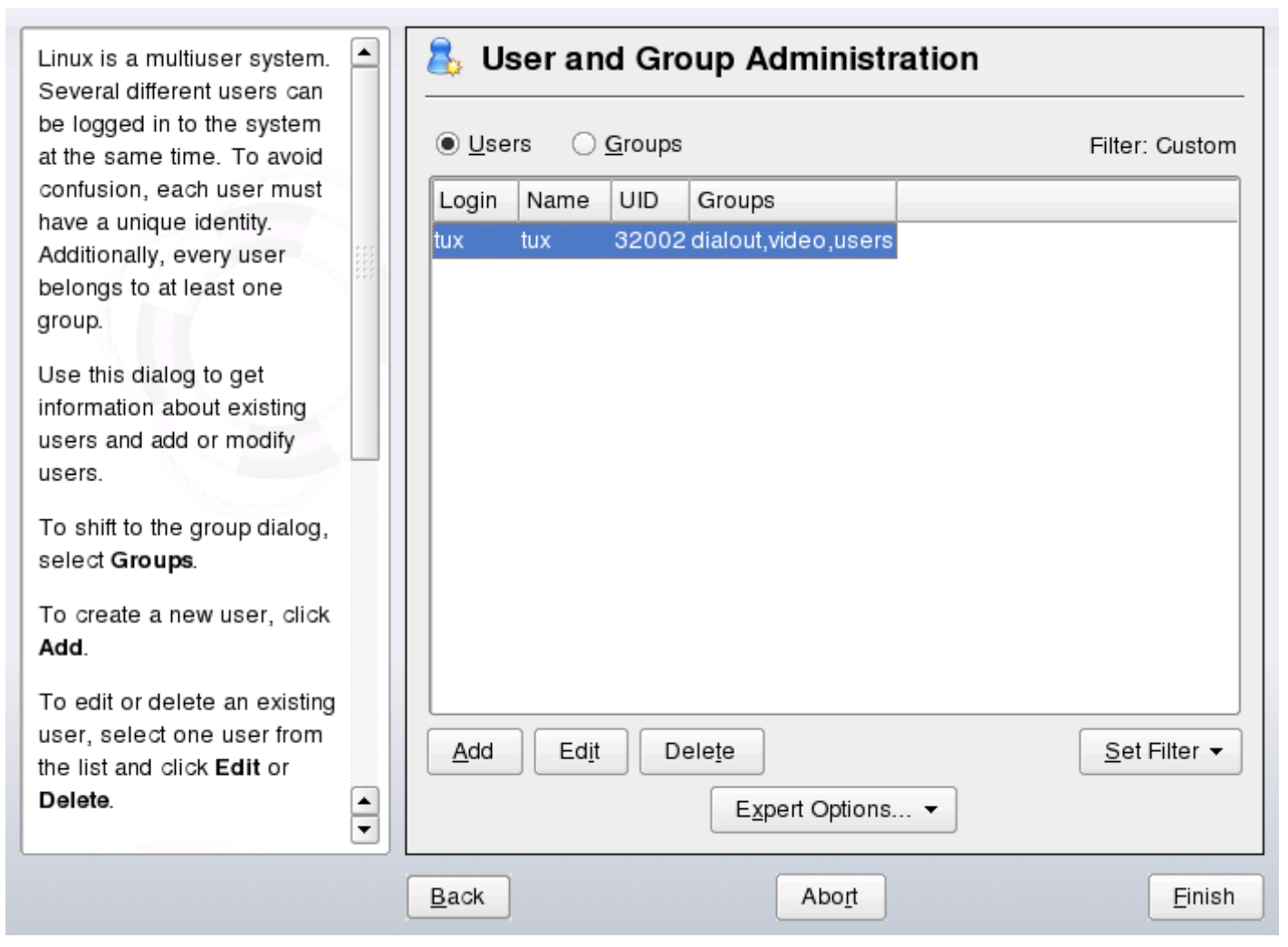
-
Select Users; then click Add to create a new user. The New Local User screen is displayed.
-
On the User Data tab, enter a username of
papercutand assign a password.
-
On the Details tab, select
Empty Homewith permissions755and change theHome Directorypath to define an alternate install location.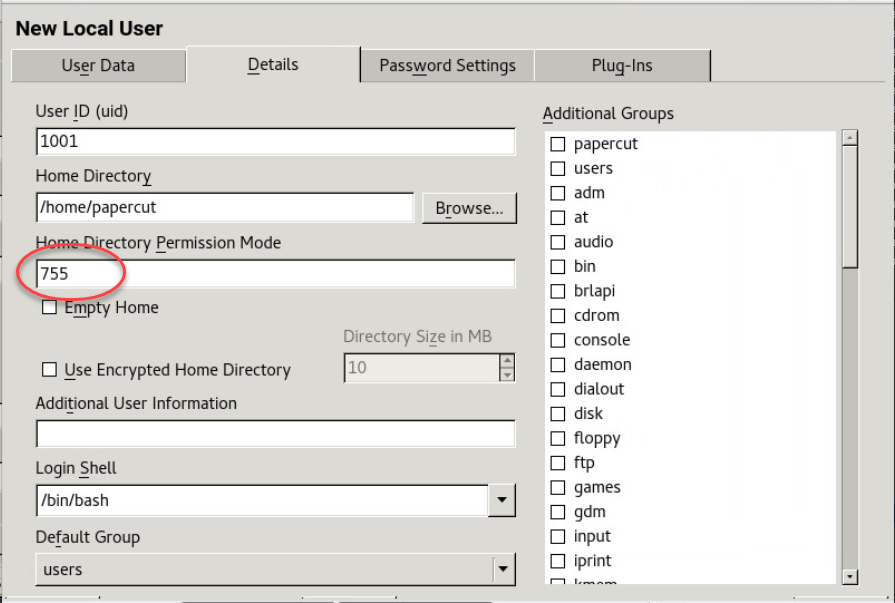
-
Click OK. The User and Group Administration screen is displayed.
-
Select Groups; then click Add. The New Local Group screen is displayed.
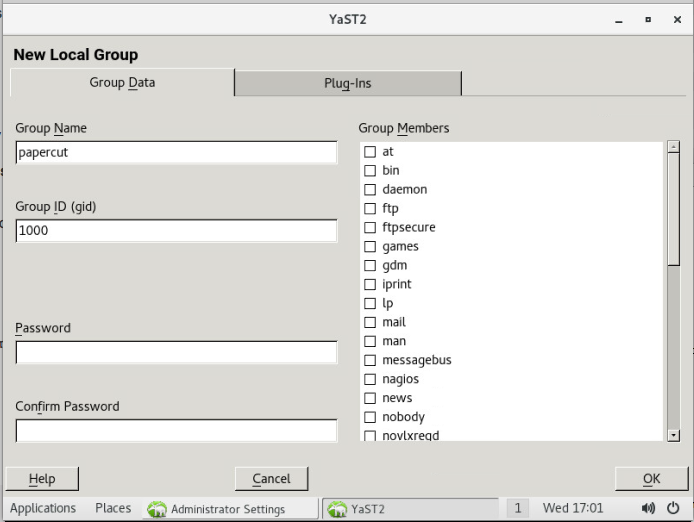
-
Type the group’s name as
papercut. -
In the Group Members list, select the new user you just added.
-
Click OK; then click Accept to create the account.
A default OES Linux installation imposes strict resource usage limits on user accounts (ulimit). The papercut account is a special account used for hosting an application so needs to be granted satisfactory resource limits such as the ability to open many files. On systemd Linux distributions, this limit is automatically configured so you do not need to do anything. For other distributions, the methods of setting user-level ulimit levels vary, however, the common solution is to add the following line to /etc/security/limits.conf:
papercut - nofile 65535
Novell OES Linux has a strict default firewall policy. PaperCut NG/MF uses TCP Ports 9191 (for HTTP), 9192 (for HTTPS/ SSL), 9193 (for Binary) and 9195 (for HTTPS/ SSL on supported devices) and these ports must be open. To open these ports:
- Open YaST Control Panel; then select Firewall under Security and Users.
- Select Allowed Services, then click Advanced.
- Add ports
9191and9192to the TCP Ports list (separated by spaces). - Click OK, Next, then Accept to apply the changes.
Step 3: Download and install PaperCut NG/MF
PaperCut NG/MF is supplied as a self-extracting and self-installing archive. The installation is performed under the rights of the newly created papercut account and temporary root access is required. Make sure the root password is handy. (Administrators who are after a detailed explanation of the install process should also consult the background information in
PaperCut NG/MF on Linux
).
Log on as the newly created papercut user and download and execute the installer from the command prompt. Here is an example using wget to fetch the installer:
shell> su - papercut
shell> wget [download url from PaperCut Software website]
shell> sh /ng-mf/pcmf-setup-novell-oes-linux.sh
Follow the installation instructions and enter the root password when requested.
The installation process takes between two and five minutes depending on the speed of the system. A system restart is not required but administrators are advised to perform installation on live production systems during periods of low activity - for example, not during backup operations or other administration activities.
Step 4: Run the Configuration Wizard
After installation, you are prompted to open a web browser at :
http://[server-name]:9191/admin
The configuration stages are explained below:
Administrative password
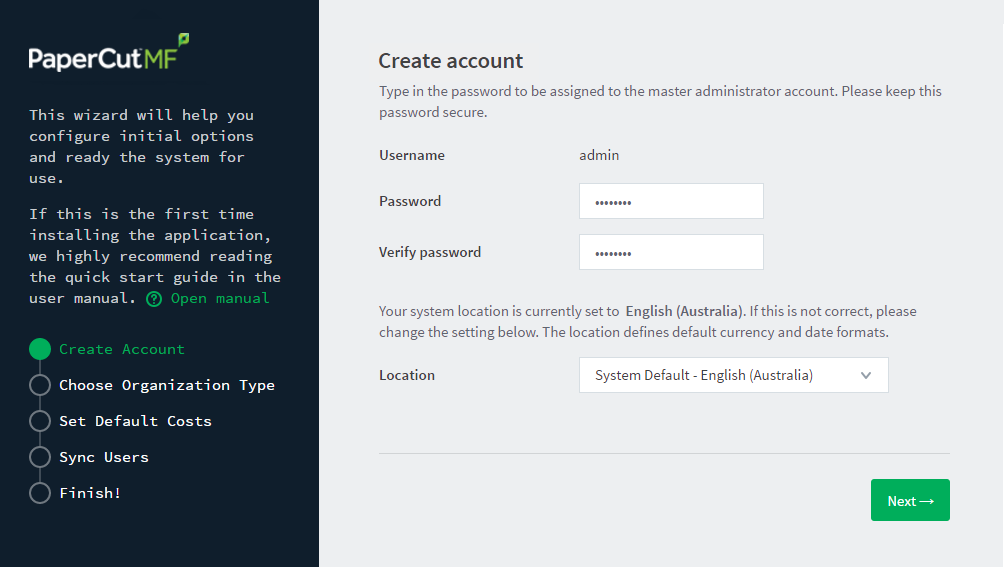
- Complete the following fields:
-
Password—enter the password for the main in-built admin account. This password is independent of the operating system or domain passwords. The password must be at least six characters.
-
Verify password—re-enter the password.
-
Location—select the system’s physical location and language.
-
- Click Next.
Organization type
The Organization type screen is displayed.
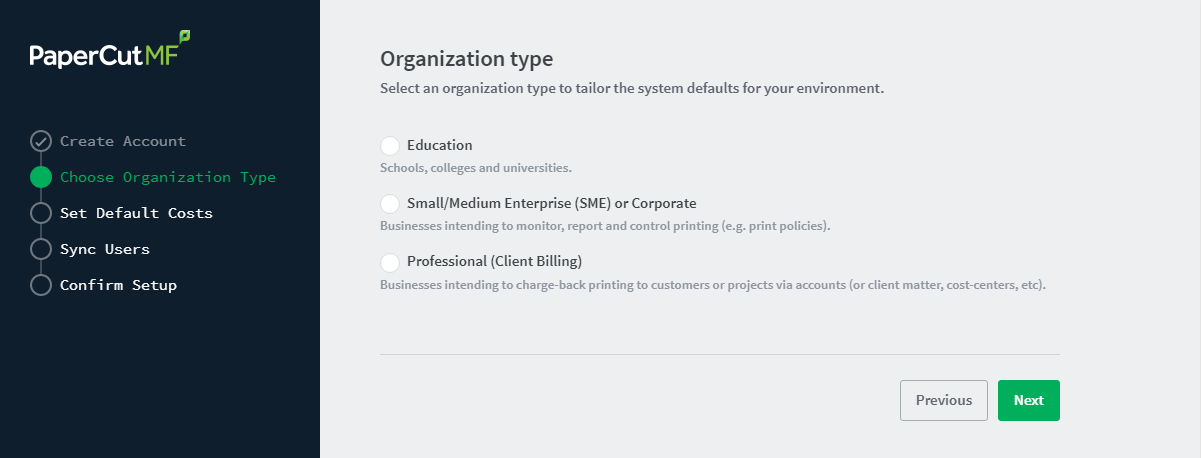
This selection determines which system defaults are used. For example, in a Professional (Client Billing) organization, where it is useful to charge-back printing to customers, an advanced client popup is provided with additional features useful for dealing with large numbers of client (shared) accounts. You can change these default settings chosen for an organization type after installation.
- Select your organization type.
- Click Next.
Default cost for printing
The Default costs for printing screen is displayed.
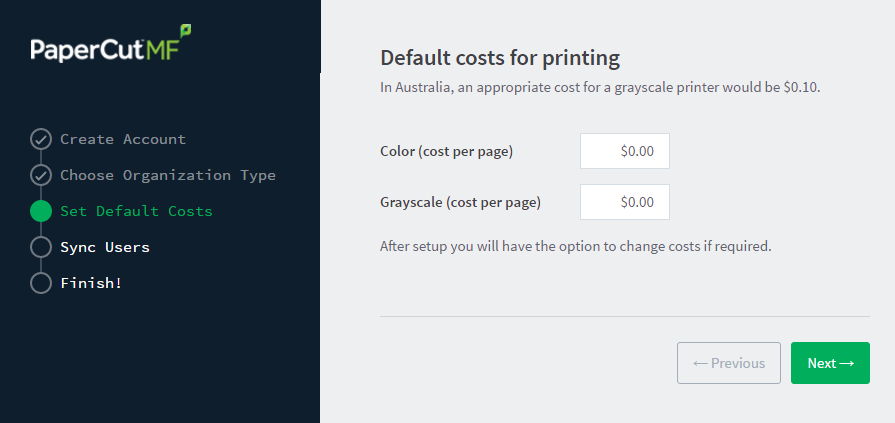
If required, you can change this setting after installation.
- Complete the following fields:
- Color (cost per page)—enter the default cost per page for color printing on all printers.
- Grayscale (cost per page)—enter the default cost per page for grayscale printing on all printers.
- Click Next.
Initial user credit (Education organization type only)
If you selected Education as the organization type, the Initial user credit screen is displayed.
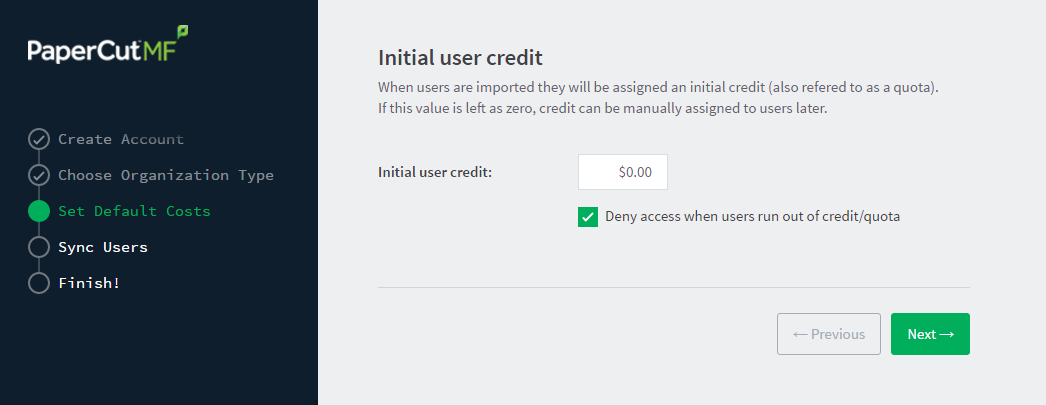
If you selected **Small/Medium Enterprise (SME) or Corporate or Professional (Client Billing) as the organization type, go to step 5.
- Complete the following fields:
-
Initial user credit—enter the amount of credit each/quota each user will receive when the system is first enabled. You can change these settings after setup.
-
Deny access when users run out of credit/quota—select this check box to prevent users from printing when they run out of credit/quota.
-
- Click Next.
User/Group Synchronization
PaperCut NG/MF extracts user information out of the System or Domain. This is usually LDAP or Google Cloud Directory. The options presented here vary depending on the Operating System and its environment. During evaluation, most sites import all users from the system/domain into PaperCut NG/MF. An option also exists to import a subset of users from a given group. This option is useful when only a subset of users will use the printers.
LDAP
PaperCut NG/MF has native support for eDirectory LDAP schemas. This is the default user import option for most sites.
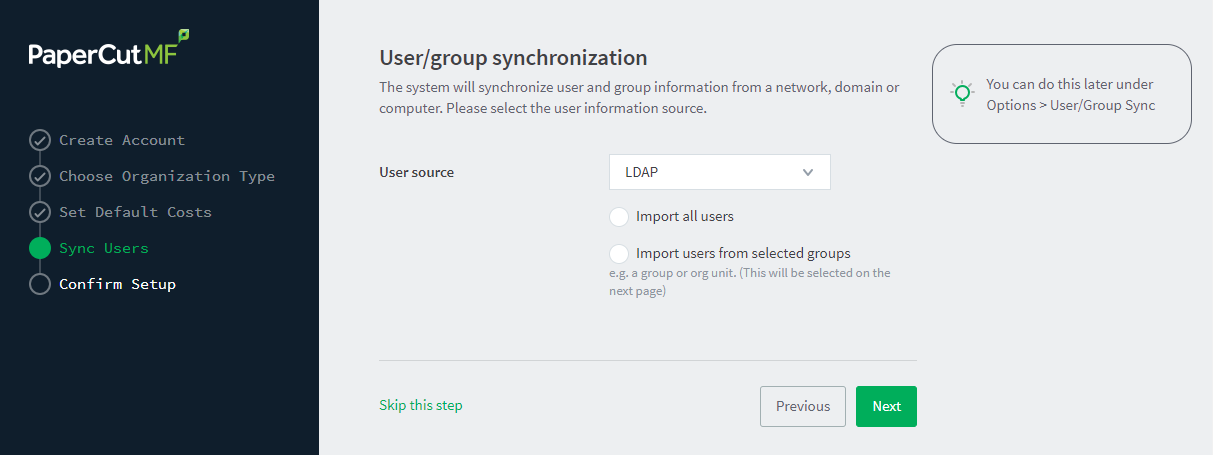
PaperCut NG/MF does its best to auto-discover LDAP settings, but some knowledge of eDirectory and/or LDAP is required. More information on LDAP is available in Synchronize user and group details with LDAP .
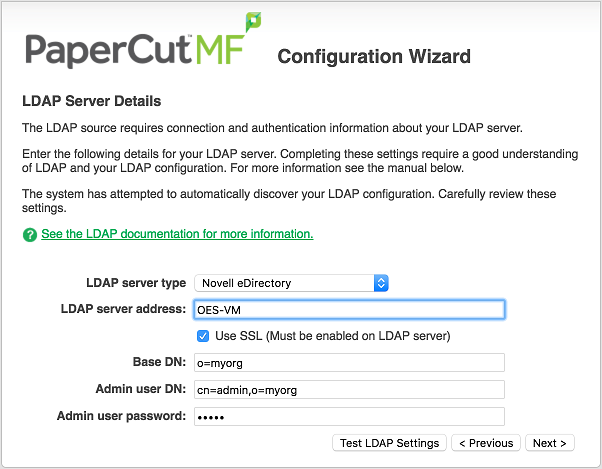
Google Cloud Directory
You also have the option to use Google Cloud Directory as the sync source. To set up Google Cloud Directory as the sync source, follow these instructions.
On the Google Cloud Directory Details screen:
Log in to accounts.google.com using your Super Admin user login details. The Google Admin console is displayed.
Click the Apps tile. The Apps screen is displayed.
Click the LDAP tile. The LDAP screen is displayed.
Click ADD CLIENT.
Type a name for the LDAP client connection you’ll be configuring to use for PaperCut NG/MF (for example, "PaperCut MF"), and optionally type a description; then click CONTINUE. The Access permissions screen is displayed.
In the Verify user credentials section, select either:
Entire domain
<domain name>Selected organizational units; then click Add and select the units from the list. (Use this to limit syncing to users in a subset of groups.)
In the Read user information section, select either
Entire domain
<domain name>Selected organizational units; then either click Copy from Verify user credentials or click Add and select the units from the list. (Use this to limit syncing to users in a subset of groups.)
Depending on your organizational policies, tick all boxes for System attributes, Public custom attributes, and Private custom attributes as this will allow PaperCut to sync primary number and secondary number from custom fields of your choice stored under individual users as per your organization's schema on Google Cloud Directory. More details on this in Installation on Novell OES Linux (iPrint).
In the Read group information section, click the switch to set it to On; then click ADD LDAP CLIENT. Google displays a confirmation message and information about downloading the certificate.
On the same screen, click Download certificate; then save the downloaded certificate (which is a PDF file) in a secure location.
Click CONTINUE TO CLIENT DETAILS. The Settings for
<ldap client name>screen is displayed.Click anywhere in the Service Status box. The Service Status screen is displayed.
Select On for everyone. The service status is updated for everyone.
Click SAVE.
User Client options (Professional Client Billing organization type only)
If you selected Professional (Client Billing), as the organization type, the User client options screen is displayed.
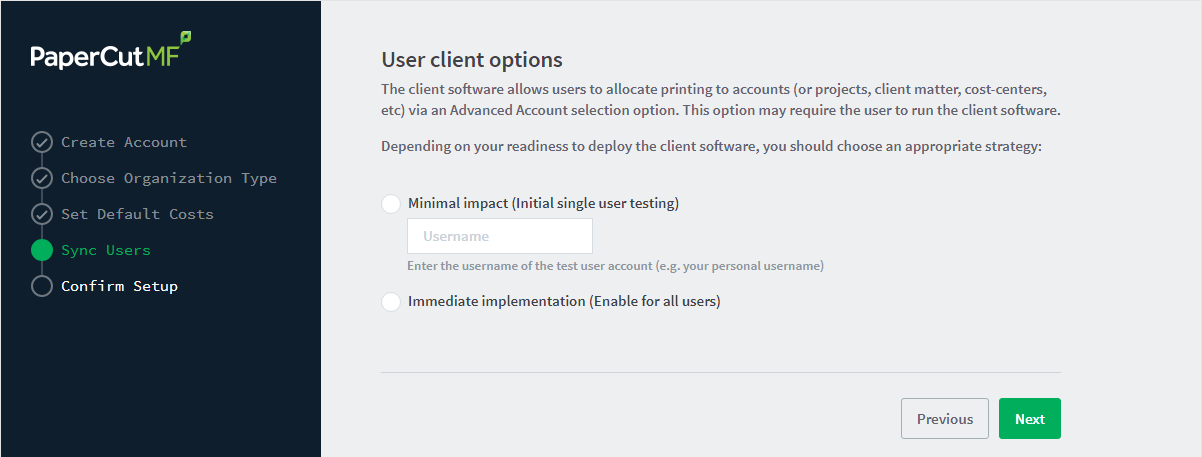
If you selected Education or Small/Medium Enterprise (SME) or Corporate, go to Confirm Setup steps.
Every print job must be charged to an account via the process of Account Selection. This may or not require user interaction and is configured at the user level.
In environments where user interaction for Account Selection is required and the user has both options - User Client and printing device - running the User Client may be optional. Hence, deploying it immediately is also optional. If you choose not to deploy it now, you can still deploy it in the future. However, in environments where user interaction for Account Selection is required and can only be done via the User Client (and cannot be done at the printing device), running the User Client is mandatory. Hence, deploying it immediately is also mandatory. If not, the user is unable to carry out the configured user interaction for Account Selection, and the job remains paused in the print queue and does not appear on the printing device. The User Client can be deployed directly from a network share (which is automatically configured on Windows). There is also the option to install the software locally on each workstation, however, this is not usually recommended because it makes the process of updating the User Client more complicated. For more information about the Account Selection options with and without user interaction (via the User Client or printing device), see Shared accounts , User Client , and Allocating accounts to print jobs at the device .
- Depending on the Account Selection configuration for users (whether or not user interaction is required and whether or not your environment caters for this on the User Client AND on the printing device), select an appropriate User Client deployment strategy:
- Immediate implementation (Enable for all users)—the Account Selection option requiring user interaction is enabled only for all users. If you have configured your users with Account Selection that requires user interaction, and this can only be done on the User Client (and cannot be done on the printing device), then you must install the User Client on all user desktops immediately to prevent disruption of user printing services. If in doubt, select the minimal impact strategy. This ensures the impact is isolated to only the nominated test account.
- Minimal impact (Initial single user testing)—the Account Selection option requiring user interaction is enabled only for a single user for testing purposes. You need to nominate the testing account; this can be an existing system/domain account used for testing purposes or your own user account. The username should be in the format used to log in to the domain/system (usually the short form). Depending on the environment, you can test the user interaction for Account Selection either on the User Client or on the printing device. The minimal impact strategy allows you to test Account Selection with user interaction using the nominated test system/domain user account, after which you can configure other users with similar Account Selection options.
- Click Next.
Confirm setup options
The Confirm setup options screen is displayed.
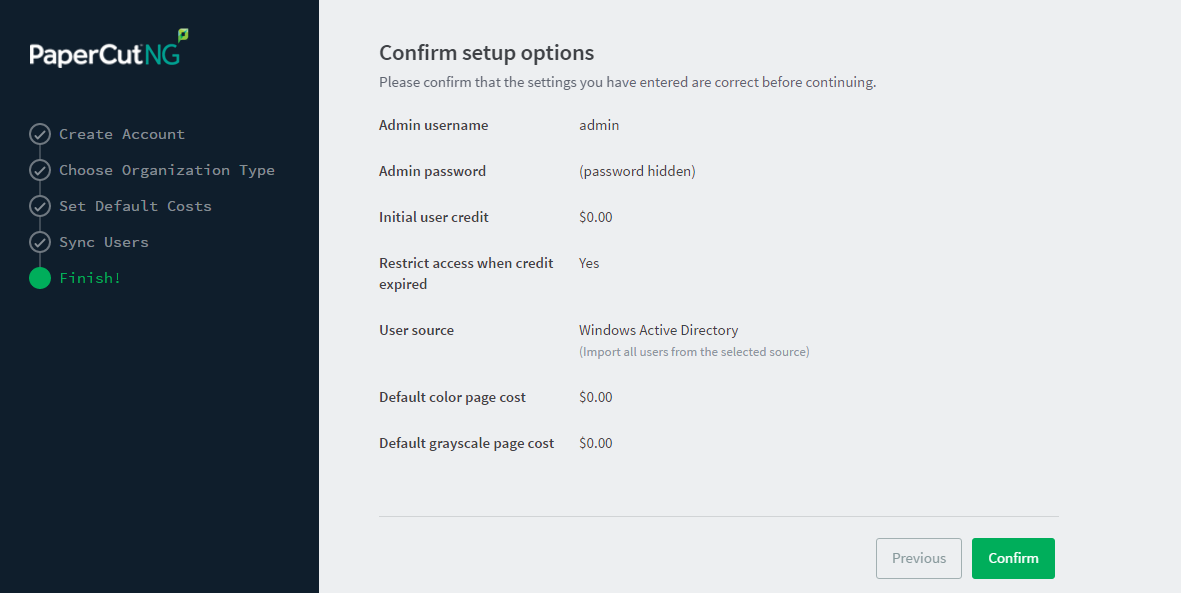
- Check the settings you have entered. If you want to change anything, you can return to any of the configuration screens to alter the options.
- Click Confirm.
The Initial user import screen is displayed. - Click Close.
Setup complete
After completing the configuration wizard you are presented with a user synchronization status screen, showing the progress and results of the setup.
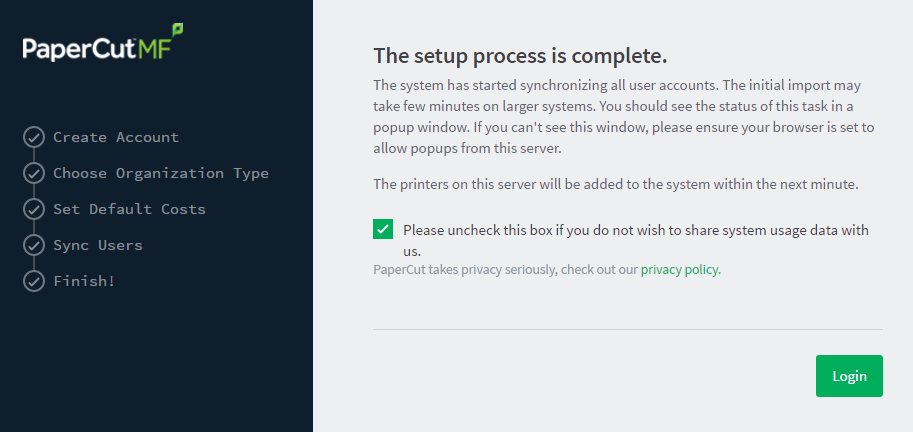
- Click Login to access the Admin web interface and begin familiarizing yourself with the options and features available. Take some time to explore, and refer back to the relevant sections of this manual as required.
Step 5: Configure the iPrint printer
PaperCut NG/MF works by directly integrating with the Novell iPrint Print Manager. iPrint must, however, be configured to use PaperCut NG/MF as an accounting control source. In the current release, this configuration is done manually at the individual print queue level:
-
Log in to iManager, expand iPrint; then select Manage Printer Manager.
-
Select the Printer Manager associated with one of your print queues.
-
Click the Manage health monitor link. A list of all your printers is displayed.
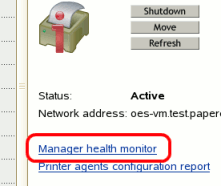
-
Select a Printer Agent from the list.
-
Click Configuration Options.
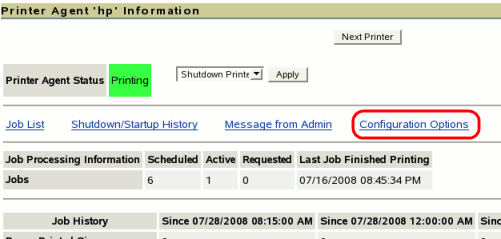
-
Enter
papercutunder the Accounting Autoload Command. Take care to write this all in lower case with no spaces.
-
Click Apply.
-
Click Back, then Back and repeat steps 4 through 7 for all printers you want monitored/controlled by PaperCut NG/MF
-
In line with best practice, backup the new printer configuration (
padbtxt.xml) as follows:- In iManager open up the active Print Manager.
- Select Manager health monitor > Advanced iPrint Manager Information > iPrint Manager Internal
- Click Backup Database.
-
Finally restart the Printer Manager in iManager by clicking Shutdown then Startup. After this, all jobs on the queues are tracked.
Step 6 - Sharing User Client software
The PaperCut NG/MF client software is located in the local directory:
/home/papercut/client
This software needs to be shared over the network so workstations can access/install the client application. Novell iManager provides a number of file sharing options. One simple solution is to add a read-only NCP or Samba share called PCClient pointing to /home/papercut/client. Established networks will benefit from ensuring the client files are available in their Distributed Files Services. The deployment of the client software (e.g. zero-install deployment) is covered in
User Client
.
Step 7: Deployment for a Professional (Client Billing) installation
Every print job must be charged to an account via the process of Account Selection. This may or not require user interaction and is configured at the user level. When Account Selection requires user interaction, then depending on your environment, the user can do so either on the User Client or on the printing device.
The User Client
In environments where user interaction for Account Selection is required and the user has both options - User Client and printing device - running the User Client may be optional. Hence, deploying it immediately is also optional. If you choose not to deploy it now, you can still deploy it in the future. However, in environments where user interaction for Account Selection is required and can only be done via the User Client (and cannot be done at the printing device), running the User Client is mandatory. Hence, deploying it immediately is also mandatory. If not, the user is unable to carry out the configured user interaction for Account Selection, and the job remains paused in the print queue and does not appear on the printing device. The User Client can be deployed directly from a network share (which is automatically configured on Windows). There is also the option to install the software locally on each workstation, however, this is not usually recommended because it makes the process of updating the User Client more complicated. For more information about the Account Selection options with and without user interaction (via the User Client or printing device), see Shared accounts , User Client , and Allocating accounts to print jobs at the device .
Account Selection
After deploying the User Client on user workstations (if required), you can configure users with the required Account Selection option (whether or not user interaction is required). For example, in a Professional (Client Billing) installation, users who print jobs for clients are often given the Advanced Account Selection option, however, other Account Selection options might be better suited for some users based on their job function.
You can configure the required Account Selection option on one user at a time or update for all users in bulk.
Use the User Details page to configure the required Account Selection option for a single user.
To configure the required Account Selection option for all users in bulk:
-
Click the Users tab.
The User List page is displayed. -
In the Actions menu, click Bulk user actions.
The Bulk User Operations page is displayed. -
In the Change settings area, select the Change account selection setting check box; then select Show advanced account selection from the list.
-
If you do not want to allow users to charge printing to their personal account (i.e. they must select a shared account) then clear the Allow user to charge to their personal account check box.
-
Click OK.
A confirmation window is displayed. -
Click OK.
Once completed, the configured Account Selection option is enabled for the selected users. If you have configured users with an Account Selection option that requires user interaction, then it is recommended that you test this from the User Client on a desktop or on the printing device (if applicable). Ensure that user interaction provided is as per the configured Account Selection option. Once the interaction is completed, ensure that the job is printed, logged and appropriate account charged.
Step 8: Testing
Following a fresh installation, it is highly recommended to test core features of the system. For further details, see Testing the installation .
What next?
Take some time to explore the features of PaperCut NG/MF before continuing reading at Implementation by example or Tour . Business users might be interested in trying the popup client software as covered in Client software . If desired, the client software should also be deployed to other workstations. This procedure is detailed in User Client .
Troubleshooting
Check out the Troubleshooting common issues with Novell OES iPrint article for more.






Comments